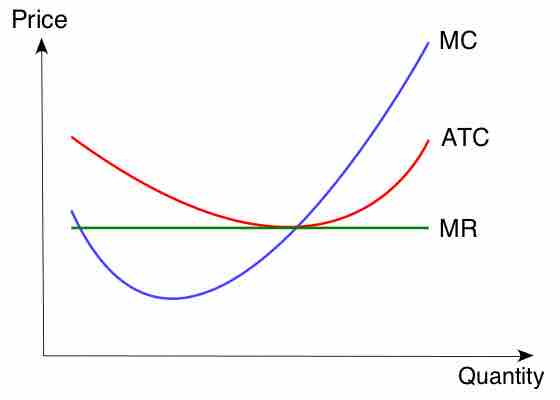Economic Shutdown
A firm will choose to implement a production shutdown when the revenue received from the sale of the goods or services produced cannot cover the variable costs of production. In this situation, a firm will lose more money when it produces goods than if it does not produce goods at all. Producing a lower output would only add to the financial losses, so a complete shutdown is required. If a firm decreased production it would still acquire variable costs not covered by revenue as well as fixed costs (costs inevitably incurred). By stopping production the firm only loses the fixed costs .

Shutdown Condition
Firms will produce as long as marginal revenue (MR) is greater than average total cost (ATC), even if it is less than the variable, or marginal cost (MC)
Economic shutdown occurs within a firm when the marginal revenue is below average variable cost at the profit-maximizing output. The goal of a firm is to maximize profits and minimize losses. When a shutdown is required the firm failed to achieve a primary goal of production by not operating at the level of output where marginal revenue equals marginal cost.
The Shutdown Rule
In the short run, a firm that is operating at a loss (where the revenue is less that the total cost or the price is less than the unit cost) must decide to operate or temporarily shutdown. The shutdown rule states that "in the short run a firm should continue to operate if price exceeds average variable costs. "
When determining whether to shutdown a firm has to compare the total revenue to the total variable costs. If the revenue the firm is making is greater than the variable cost (R>VC) then the firm is covering it's variable costs and there is additional revenue to partially or entirely cover the fixed costs. One the other hand, if the variable cost is greater than the revenue being made (VC>R) then the firm is not even covering production costs and it should be shutdown immediately.
Implications of a Shutdown
The decision to shutdown production is usually temporary. It does not automatically mean that a firm is going out of business. If the market conditions improve, due to prices increasing or production costs falling, then the firm can resume production. Shutdowns are short run decisions. When a firm shuts down it still retains capital assets, but cannot leave the industry or avoid paying its fixed costs.
A firm cannot incur losses indefinitely which impacts long run decisions. When a shutdown last for an extended period of time, a firm has to decide whether to continue to business or leave the industry. The decision to exit is made over a period of time. A firm that exits an industry does not earn any revenue, but is also does not incur fixed or variable costs.